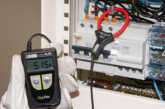
David Sweetman, Marketing Manager at Di-Log, discusses the importance of safe isolation.
Every electrician with experience of working on a busy site knows how it feels to take responsibility for the other tradesmen around them. When you are dealing with live electricity there’s no room for calculated risks and educated guesses. The only way you can ensure the safety of you and your colleagues is through adopting adequate safe isolation procedures.
For electrical systems where the supply has been cut off to allow dead working, Regulation 13 of the Electricity at work Regulations 1989 applies as follows:
“Adequate precautions shall be taken to prevent electrical equipment, which has been made dead in order to prevent danger while work is carried out on or near that equipment, from becoming electrically charged during that work if danger may thereby arise.”
This establishes a clear requirement to ensure that conductors and equipment may not be inadvertently energised. In other words, safe isolation.
In practise this means not only cutting off the supply, but also ensuring the method of disconnection is secured in the OFF position and a caution notice or label is posted at the point of disconnection.
Safe Isolation procedures
Isolation of equipment or circuits using the main switch or distribution board switch disconnector is the preferred method. The method of isolation should be locked off using a unique key, retained by the person carrying out the work, and a caution notice posted at the point of isolation.
Where more than one operative is working on a circuit, a multi-lock hasp can be used to prevent operation of the main isolator until such time as all persons working on the installation have completed their work and removed their padlocks from the hasp.
“Electricians who regularly work on installations that have been energised should be equipped with devices for proving that conductors are dead.”
Proving dead isolated equipment or circuits
Following isolation of equipment or circuits and before starting work it should be proved that areas you are about to work on are in fact dead. The recommended method for doing is by use of a test lamp or a two pole tester (as recommended in HSE Guidance Note 38).
The test lamp or voltage detector should be proved to be working on a known live source or a proprietary proving unit. All line, neutral, and protective conductors should be tested to prove they are dead.
Electricians who regularly work on installations that have been energised should be equipped with devices for proving that conductors are dead. Di-Log latest range of safety equipment for working on LV Electrical Equipment includes an array of Lockout Kits, ranging from a simple single MCB ‘Personal Lockout Kit’ for isolation of individual circuits through to the industrial ‘Expert Lockout Kit’ with mostly fully insulated lockout devices for virtually all individual and main sources of energisation.
The Di-Log range of ‘Lockout Kits’ are designed with safety, versatility and affordability in mind. With the entry level DLLOC1 – Personal Lockout Kit, you get a 38mm steel padlock, a universal MCB lock, a standard ‘Pins-out’ MCB Lock and Warning Tag.
The higher the level of kit the more features are included. By adding items such as multiple isolation lockout hasps, the kits enable multiple persons to work on the same circuit, with the ability to hold up to six lockout padlocks.
The DLLOC3 – Professional and DLLOC4 – Expert kits provide more scope to safely isolate a broader range of MCB’s and Main switches. Items such as the larger universal MCB lockout device, large main switch lockout device, and with a fully insulated padlock and hasp, ensure all commercial and industrial applications are covered.
ISOPK1 and ISOPK2
To fully conform to the ‘Safe Isolation Procedure’, and in addition to the above, once the circuit or main source of energy has been isolated, the conductors must be proved to be dead at the point of work before they are touched and, where necessary, caution notices should also be applied at the point(s) of isolation. With this in mind, Di-Log has combined its Lockout Kits with its award winning 2-Pole Combivolt Voltage Indicators and its PU260 – 690V 2-Pole Voltage Proving Unit to create the all new ISOPK1 – CombiVolt 1 Safe Isolation Kit c/w DLLOC1 and ISOPK2 – CombiVolt 2 Safe Isolation Kit c/w DLLOC2.
The CombiVolt Voltage and Continuity Indicators are packed with features, such as single pole voltage indication (even when the batteries are depleted), phase rotation and non-trip phase to PE indication. The also fully conform to all standards, including the vital BS EN 61243-3-2015.
The PU260 – 690V Proving features LED indication if your 2-pole tester draws excessive current above3.5mA, thus not conforming to standards such a ‘Protection against Electric Shock’.
With all the above combined together, Di-Log can confidently boast that they offer one of the most comprehensive Safe Isolation Kits available to the UK market.








